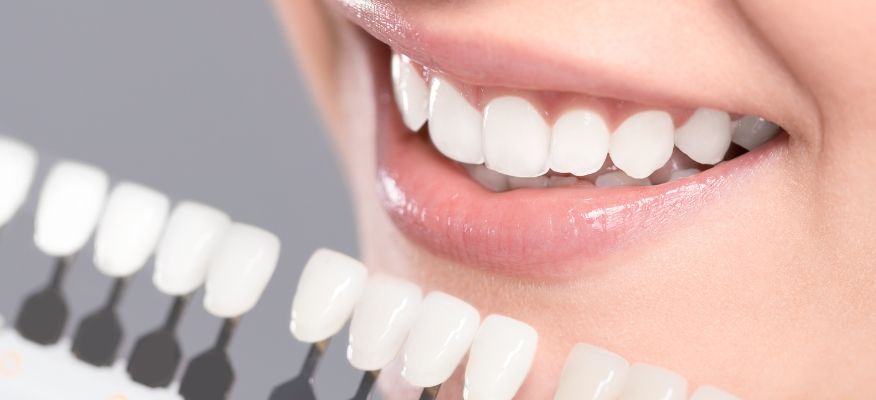
Nowadays, tooth whitening is one of the most popular treatments that patients ask their dentists for. However, there are several doubts and myths that need to be clarified. One of the most frequently asked questions is whether whitening damages tooth enamel.
The answer is simple: when carried out by a dentist in a controlled environment and with the correct products, tooth whitening is completely safe and harmless to the tooth.
What is teeth whitening?
Teeth whitening consists of applying a whitening gel/agent, usually hydrogen peroxide or carbamide peroxide, to the tooth.
This agent, after decomposing into oxygen and by-products, has the ability to penetrate the tooth matrix and release the internal molecules that cause the tooth to darken. In this simple way, the tooth automatically takes on a lighter colour.
How to carry out external whitening
-
In the consulting room: applying higher concentrations (usually 35%) for a short period (around 15-30 minutes), sometimes using a light source (usually called a laser) to activate or accelerate the action of the whitening agent.
-
At home (or outpatient): where the patient uses trays adapted to their dentition to apply a gel with a lower concentration (10 or 16%) for around 4 hours a day for one to two weeks.
In both cases the result is whiter teeth, although the first option is faster but less long-lasting and the second slower but with a more stable result. It’s important to remember that although it’s a chemical process, it’s completely neutral to dental tissues.
Teeth whitening mistakes and myths
Not everyone needs the treatment
It’s important to note that not all patients can undergo whitening, and there are also patients who have no indication for this cosmetic procedure. It is therefore important to carry out a careful assessment so that the treatment is safe.
For example, there are patients who have whitened teeth but they are covered in pigment or calculus. In these cases, an oral hygiene appointment with a jet of bicarbonate is enough to restore the light colour of the teeth.
Likewise, patients with active caries and periodontitis cannot have this treatment until these diseases are under control.
Teeth whitening only works on the natural tooth
People who have extensive restorations on their front teeth, such as crowns or bridges, need to pay special attention, as they may need to be replaced at the end of the whitening process so that the colour is even again.
Whitening pastes are not recommended
Another common mistake patients make with this cosmetic procedure is using whitening pastes on the market that have not been scientifically proven and are based on acidic and abrasive agents that irreversibly scratch and demineralise the enamel.
Dentist’s Advice
The advice that remains is to always carry out this procedure safely and to seek advice from your dentist.
At Instituto Dentário do Alto dos Moinhos we always start this procedure with an assessment, diagnosis and planning consultation where we discuss with the patient the best type of whitening depending on the patient’s teeth and goals.
This is followed by an oral hygiene appointment to remove all pigments and calculus, and then the whitening treatment itself.
It’s important to remember that this procedure is not permanent and will require ongoing maintenance if the results are to be as long-lasting as possible.

Dr. Carlos Almeida
Dentist (Registered with the Ordem do Médicos Dentistas under Nº 5873)
| Exclusive practice in Implantology and Oral Rehabilitation
| Co-Founder of Instituto Dentário do Alto dos Moinhos
